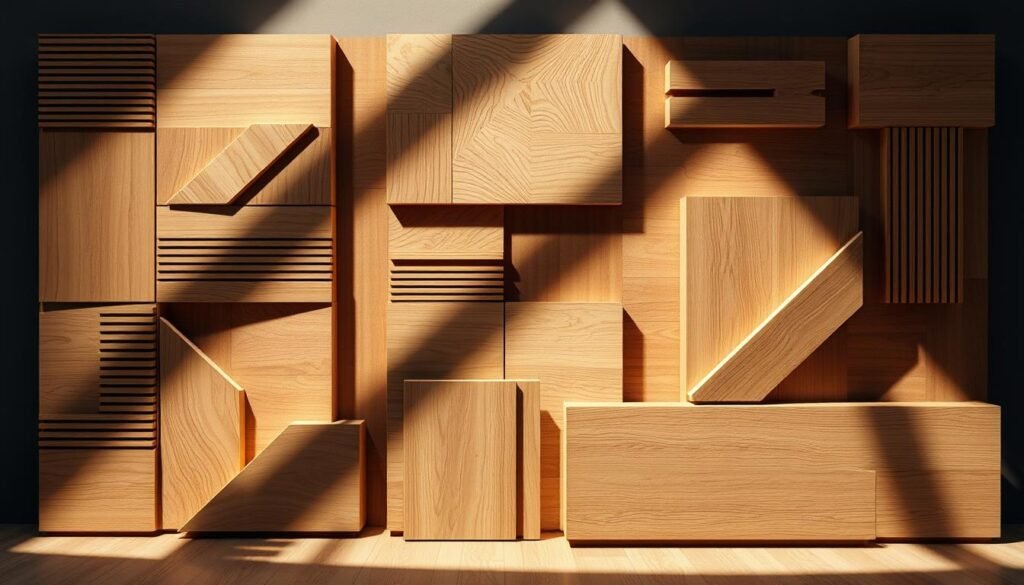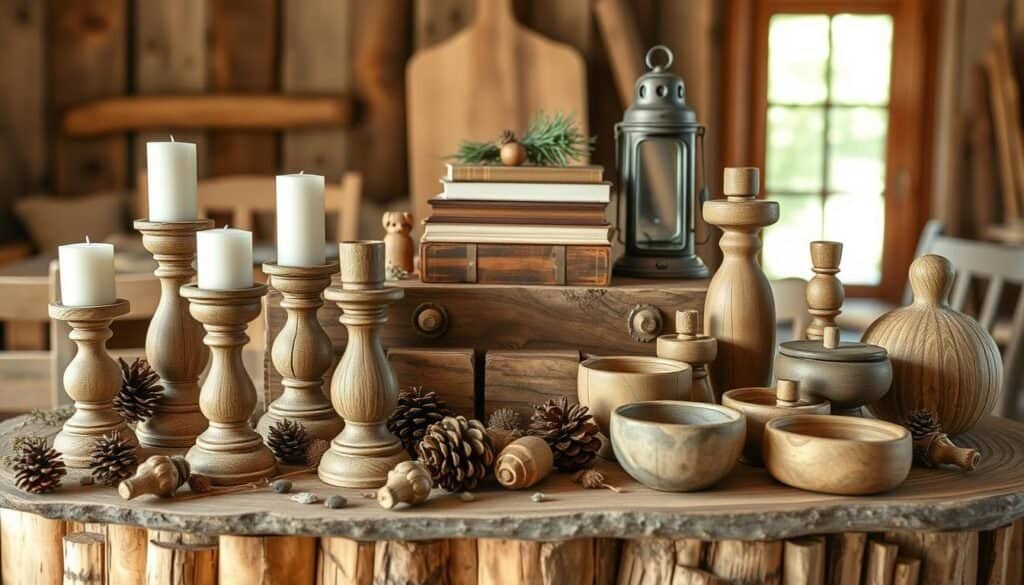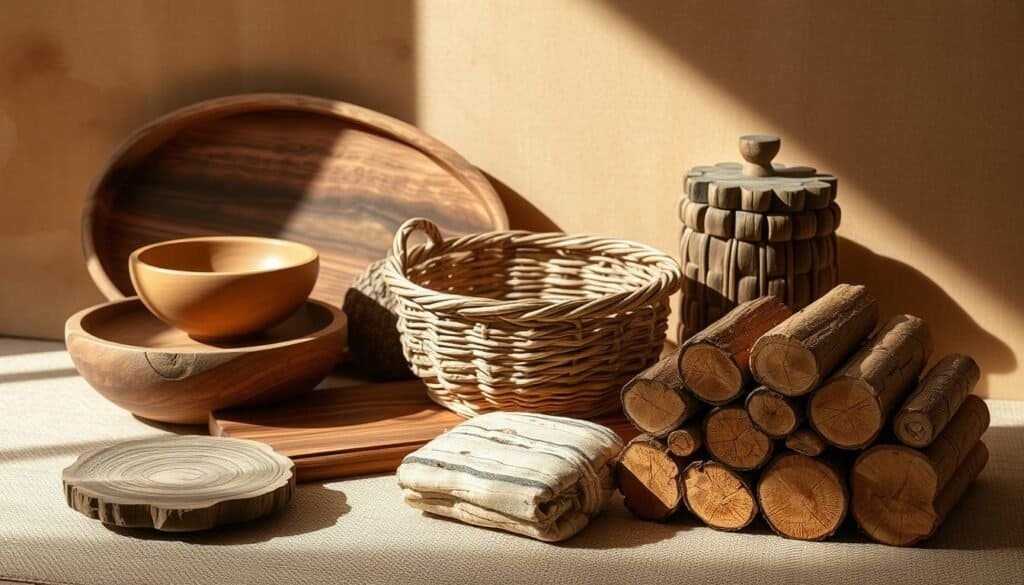Woodworking is all about the little things. The right finishing touches can turn a simple piece into a masterpiece. It’s these details that make all the difference.
Whether you’re new to woodworking or have years of experience, finishing is key. The right techniques can add elegance and sophistication to your work.
This article will dive into wood finishing techniques. We’ll share tips and inspiration to help you create exceptional pieces. Get ready to elevate your woodworking projects.
The Power of Wood Finishing: Beyond the Basics
Wood finishing is more than just applying a coat. It’s an art that brings out the wood’s natural beauty. It also protects the wood and shows off the woodworker’s skill.
There are many wood finishing techniques to explore. Each has its own benefits and challenges. You can choose from oil-based, water-based, or eco-friendly finishes. The right choice depends on the wood, project use, and look you want.
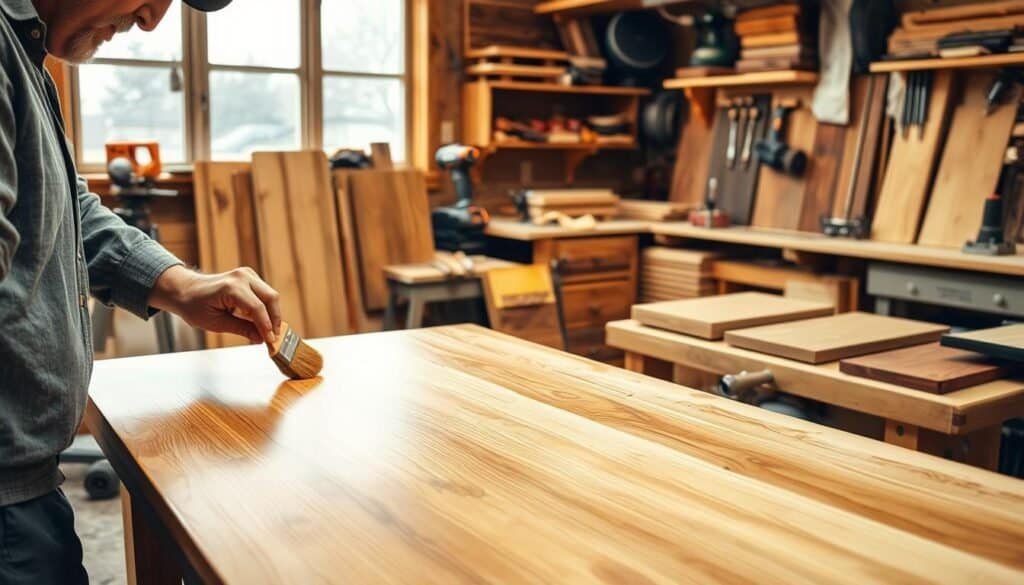
Unique wood finishes can be made in different ways. Staining, painting, and special finishes are just a few. For example, a good stain can highlight the wood grain. A special finish can add a unique texture or shine.
Finishing wood projects makes them look better and last longer. A well-finished project can handle wear and tear. It can also resist moisture and need less upkeep. For tips on improving your wood projects, check out The Sawdust Man.
In summary, mastering woodworking craftsmanship means knowing how to finish wood right. By picking the right finish and method, woodworkers can make their projects stunning and long-lasting.
Surface Preparation Techniques That Elevate Your Work
Getting a flawless finish in woodworking starts with the right surface preparation. This step is key to your project’s quality. It’s the base for a stunning finish, more than just sanding.
To get your wood ready, understanding grit progression is vital.
Choosing the Right Grit Progression
The grit progression is the order of sandpaper grits for sanding. Start with a coarse grit (80-100) to remove old finishes and scratches. Then, move to finer grits (120-150, then 220) to smooth out the surface.
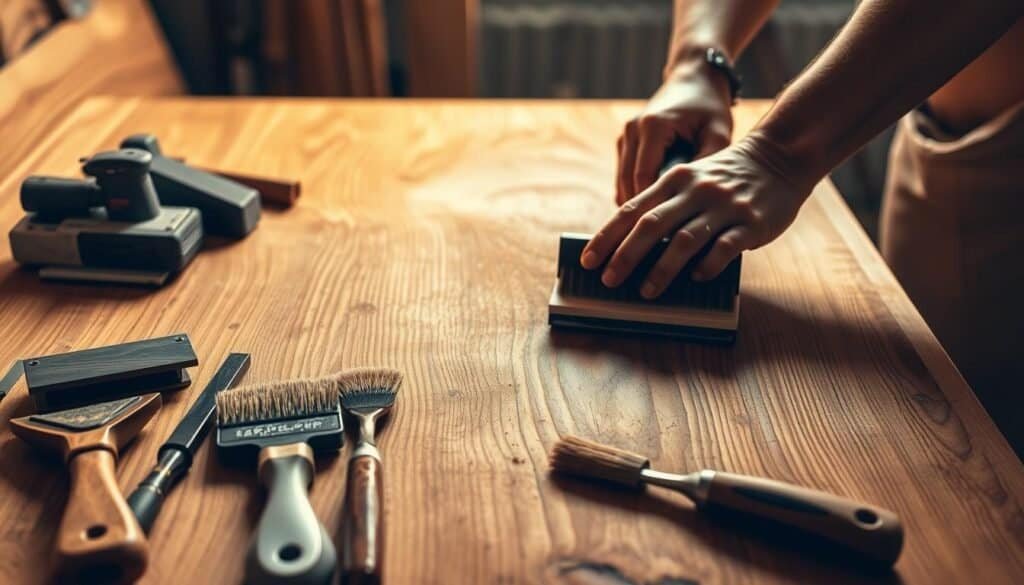
For most projects, using grits 80-120-220 is enough. But for a super smooth finish, go up to 320-400 grits. Always sand with the wood grain to avoid scratches. Use a sanding block for flat areas to keep it even.
Hand vs. Machine Sanding Approaches
Woodworkers often choose between hand sanding and machine sanding. Hand sanding is better for small areas and fine details. It’s quieter and makes less dust than machine sanding.
Machine sanding is quicker for big, flat areas. Belt sanders are good for removing old finishes and smoothing rough wood. Orbital sanders are best for the final sanding before finishing. Always move through the grits progressively for a smooth finish.
In conclusion, proper surface preparation is essential for a great woodworking project. By picking the right grit progression and sanding method, you can get a smooth, even surface. Whether you’re experienced or just starting, these techniques will make your work look professional.
Essential Finishing Touches in Wood That Make a Big Difference
The right finishing techniques can change a wooden piece, making it look better and last longer. It’s important to look at both old and new methods when choosing finishing touches.
Traditional Oil Finishes
Traditional oil finishes have been used in woodworking for a long time. They are a natural, safe way to protect and make wood look better. Finishes like tung oil and linseed oil are popular because they last long and are easy to use.
Using traditional oil finishes takes time because you need to apply many coats. But, the end result is a finish that makes the wood look warm and rich.
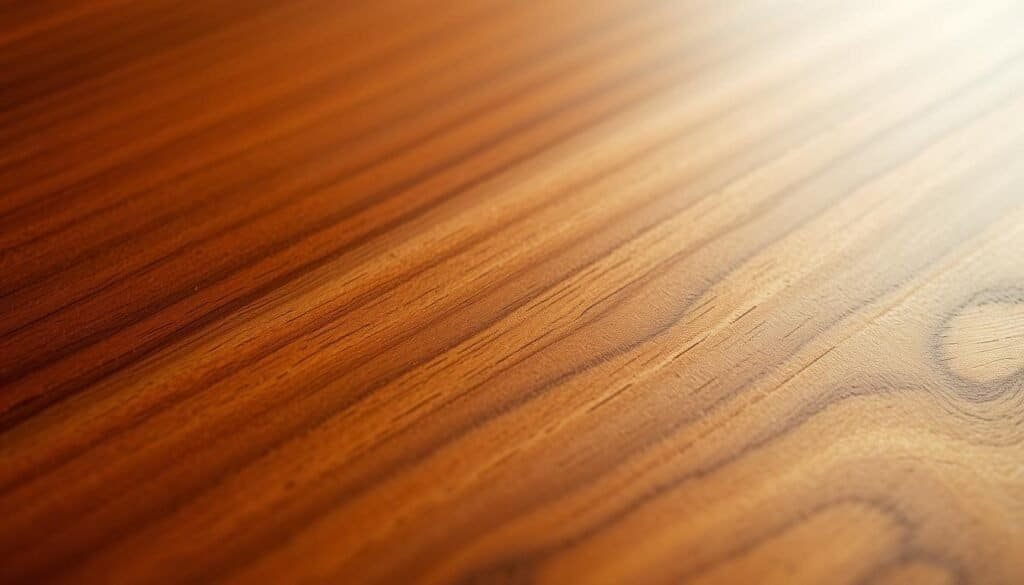
Modern hardwax oils are a better choice for durability and water resistance. They mix the benefits of oil and wax, creating a hard, protective layer. This is great for items that get a lot of use, like furniture and floors.
Hardwax oils are simple to apply and keep up with. They come in different sheens and work well on many types of wood. This makes them a favorite among both experts and DIY fans.
Choosing between traditional oil finishes and modern hardwax oils depends on what you want. The most important thing is to prepare the surface well and apply the finish correctly. This way, you can make sure your wood looks great and lasts a long time.
Texture and Relief: Adding Dimension to Wood Surfaces
Texture and relief are key in woodworking. They add depth and character to your creations. By using different techniques, you can turn a simple wood surface into a stunning piece of art.
Carving is a great way to add texture and relief. It lets you make detailed designs and patterns. These not only look good but also feel good to touch.
Basic Relief Carving Methods
Relief carving involves carving a design into the wood. This creates a raised pattern or image. To begin, you need to know the basics of carving tools and techniques.
First, choose the right wood for your project. Softwoods like pine or fir are good for beginners. Hardwoods like oak or maple are more durable.
Tools for Effective Wood Carving
The right tools are key for wood carving. You’ll need gouges, chisels, and mallets. Gouges help remove wood and create curves. Chisels are best for details and sharp edges.
Good tools make a big difference in your carvings. Look for durable materials and comfortable handles.
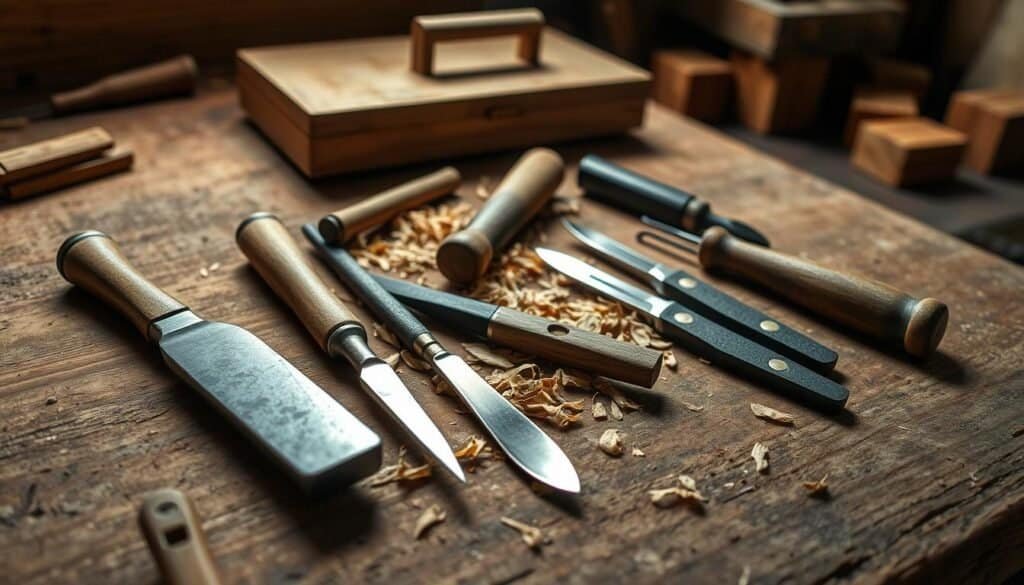
Mastering texture and relief techniques can elevate your woodworking. Whether it’s a wooden sculpture on log or detailed art design, the right tools and methods will make your work look professional.
Edge Treatments and Joinery Details
Edge treatments and joinery details are key in woodworking. They make a piece go from useful to truly special. The way edges are finished and joints are made can change how a woodwork piece looks and lasts.

Edge treatments can be simple or complex, each with its own purpose. They might make a piece safer, stronger, or more beautiful. Joinery details, on the other hand, are vital for a piece’s strength. Traditional joinery shows the skill and craftsmanship of woodworkers over generations.
Traditional Joinery Showcase
Traditional joinery includes methods like mortise and tenon, dovetail, and dado joints. These joints are strong and add a touch of craftsmanship that woodworkers value. For example, dovetail joints are strong against pull-out forces, making them great for drawers and cabinets.
Modern Interpretations of Classic Joints
Modern woodworkers mix traditional techniques with new designs and materials. This mix of old and new creates unique and innovative pieces. It honors the past while exploring new possibilities in woodworking.
Choosing between traditional and modern joinery depends on the project. It’s about the look, the wood, and the piece’s function. By picking the right edge treatments and joinery, woodworkers can make their work stand out.
Wood Wall Art and Decorative Applications
Adding wood wall art to your home can change everything. It brings warmth and character to any room. You can choose from rustic to modern designs, making your space truly yours.
Wood wall art is very versatile. You can use a big piece to make a statement or small ones for a subtle look. For example, a reclaimed wood piece can warm up a living room. A geometric design can modernize a bedroom.
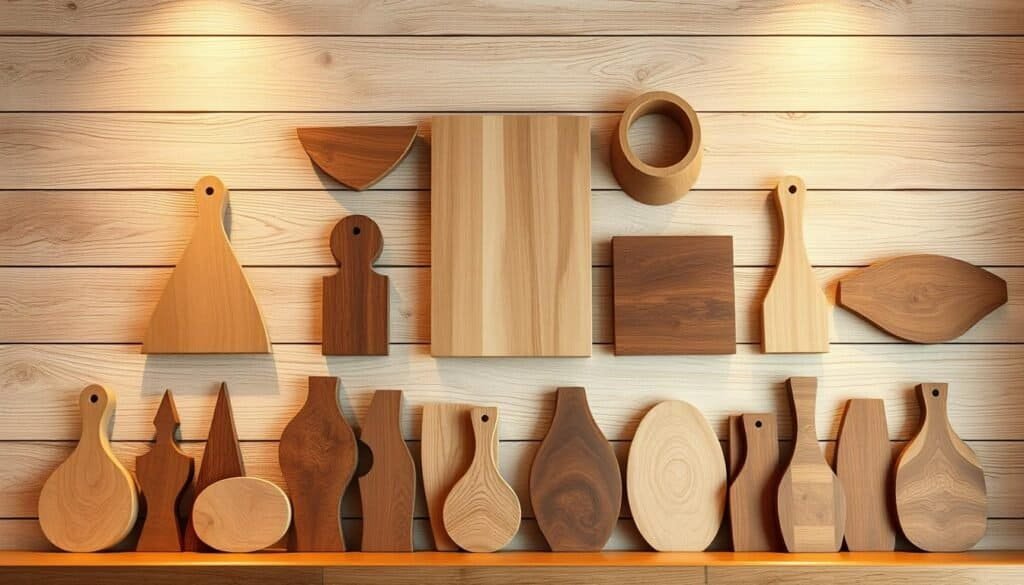
There are many ways to use wood wall art in your decor. You can have a big piece or a collection of smaller ones. Rustic art adds coziness, while geometric designs bring a sleek look.
Think about your room’s style before choosing wood wall art. Modern rooms look great with geometric patterns. Traditional or rustic rooms do well with distressed finishes and natural textures. Mixing wood with metal or glass can create a unique display.
In short, wood wall art is a great way to improve your home’s look. It combines natural beauty with sophistication. Whether you like rustic or modern, there’s a piece for you to enhance your space.
Specialty Finishes and Treatments
Specialty finishes and treatments have changed the woodworking world. They give woodworkers many creative options. These advanced methods help make wood creations look amazing and last longer.
One cool use of these finishes is in making river tables and resin art. River tables look like rivers, adding elegance to any space.
River Tables and Resin Art
River tables mix wood with special resin, sometimes with extra colors or materials. The resin is poured into a wood cavity, then sanded and polished until it shines.
This makes a beautiful, unique piece that shows off the wood and resin. 
Resin art is getting more popular. It lets woodworkers and artists be creative. They can make stunning, functional pieces with different colors and textures.
Small-Scale Resin Accents
Small resin accents can also make a big impact. They can be used for things like coasters or pendants. These accents are perfect for adding a special touch to small projects.
These accents are made the same way as river tables but on a smaller scale. Woodworkers can create detailed designs with the resin. This adds a unique flair to their work.
Using specialty finishes and treatments, like resin art and small accents, lets woodworkers create amazing pieces. These pieces show off their skill and creativity.
Hardware and Complementary Materials
Hardware and complementary materials are key to making any woodworking project look great. The right choice can make your creations stand out. They add beauty and function to your work.
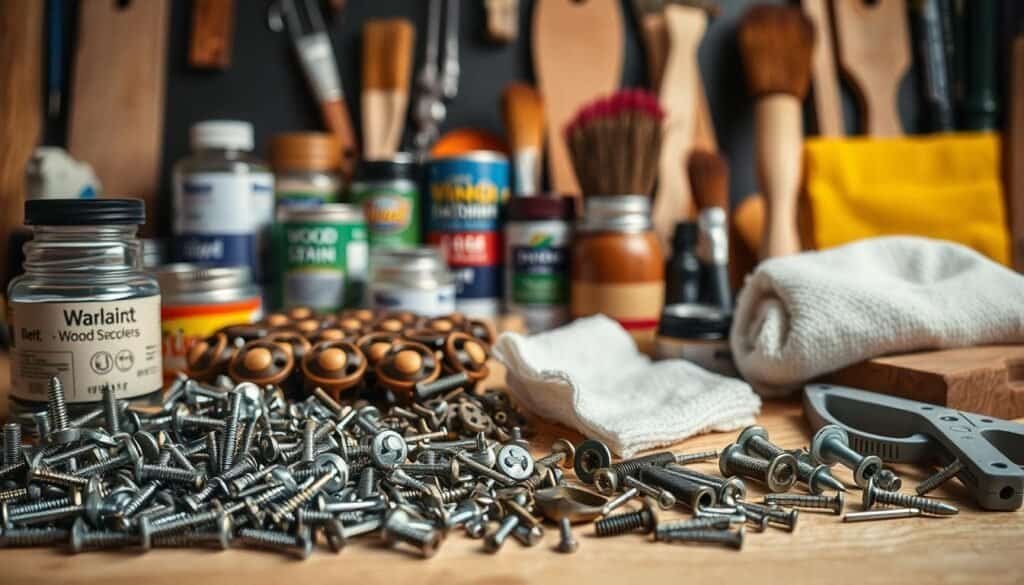
Woodworkers often debate between traditional and contemporary hardware styles. Traditional styles, like antique brass or bronze, bring a classic feel. They fit well with historical or vintage decor, adding warmth and authenticity.
Contemporary styles, with finishes like chrome or matte black, offer a modern look. These are ideal for those who like a minimalist style or are working on modern projects.
Custom Hardware Options
Custom hardware can add a unique touch to your projects. It can include handmade metalwork or personalized engravings. This lets you match your hardware to your project’s theme or style.
Custom hardware also lets you add personal or brand identity to your work. This makes each piece special. Whether for a client or a personal project, custom hardware can take your work to the next level.
In conclusion, choosing the right hardware and materials is vital in woodworking. It affects how your projects look and function. By exploring different styles and custom options, you can make sure your creations meet and exceed your goals.
Conclusion: Bringing Your Woodworking to the Next Level
Finishing touches in woodworking can really change how a project looks and feels. By using the methods we talked about, you can make your projects stand out. This includes everything from getting the surface ready to adding special finishes.
Whether you’re making a piece of wall decor or a big furniture item, the right finishing touches can make it amazing. Using woodworking tips and techniques can improve your projects. This way, you can make your skills better and create unique pieces.
Keep practicing and being patient as you work on your projects. Trying new techniques and materials can help you find your own style. This way, you can show off your skills in your woodworking.

